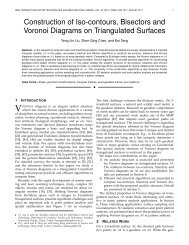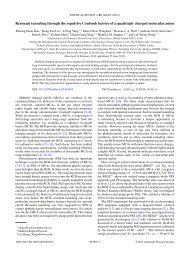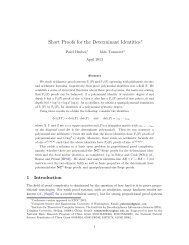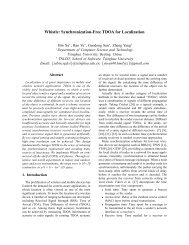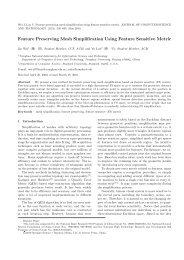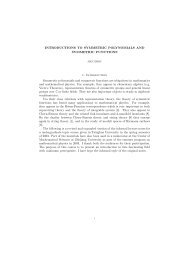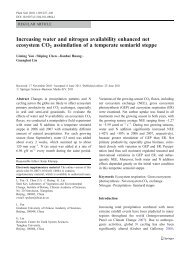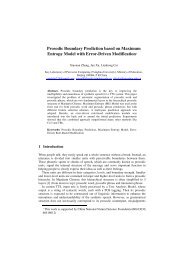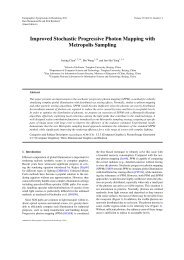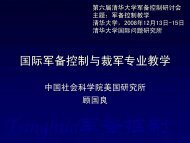Industrial design using interpolatory discrete developable surfaces
Industrial design using interpolatory discrete developable surfaces
Industrial design using interpolatory discrete developable surfaces
Create successful ePaper yourself
Turn your PDF publications into a flip-book with our unique Google optimized e-Paper software.
Y.-J. Liu et al. / Computer-Aided Design 43 (2011) 1089–1098 1091Fig. 1.The interface of the working system. Left: A screen snapshot. Right: A typical working environment of the sketching system.Table 1Some notations used in this paper.NotationT(P)OT(P)πP 2DSupporting line segment (SLS)A rung ⟨m, n⟩A gate rungA regular rungOptimal rungBridge triangulation BT(P)OBT(P)L(i)MeaningA boundary triangulation of PThe optimal boundary triangulation of PThat maximizes the measure M(T).The sketch planeThe projection of P onto πA line segment inside P that starts at someVertex p i ∈ P, goes through some concaveVertex p j ∈ P and ends in an edge of P.A line segment connecting p m and p n that isEntirely inside P except its two ends.A rung that is a part of an SLSA rung that is not a gate rungA rung that is an edge in OT(P)A boundary triangulation in which everytriangle has at most two rungs.The optimal bridge triangulation of P thatMaximizes the measure M(BT).The set of valid rungs emanating from p iFig. 2. Polyline resampling: Supporting line segment (SLS), gate and regular rungs.Let P discretize smooth curves C. The vertices in P are orientedso that when one walks along the P, the interior region boundedby P (P possibly has several disjoint closed polylines) is always onthe right-hand side. For any boundary triangulation T of P, eachedge e ∈ T consists of two vertices p i , p j ∈ V P . Denote the tangentvectors in the smooth curves C at the positions of p i , p j by t i , t j ,respectively. The <strong>discrete</strong> normal vector to the <strong>discrete</strong> surface Tat position p i , with respect to p j , is defined by n j i= (p j−p i )×t i∥(p j −p i )×t i ∥ . Atwist measure of edge e = (p i , p j ) is defined bym(e) =n j · i ni − 1, j e ∉ P0 e ∈ P.The <strong>discrete</strong> developability of T is measured by the total twistM(T):M(T) =m(e). (1)e∈T,e∉PSince the measure m(e) is always less than or equal to zero,and m(e) = 0 only if perfect developability is achieved, givenan T , the larger M(T) is, the better the developability obtained.Note that a similar measure of developability for semi-<strong>discrete</strong><strong>surfaces</strong> is used in [31] to define <strong>developable</strong> surface strips.Among all the possible boundary triangulations of P, let OTbe the triangulation that maximizes the measure M(T). If thesampling density of P is increased to the infinate, the boundarytriangulation OT(P) maximizing the developablity measure (1)converges to a smooth <strong>developable</strong> surface or a composition ofseveral <strong>developable</strong> <strong>surfaces</strong> joined along crease lines, while otherboundary triangulations may converge only to a ruled surface. Inthis paper, OT(P) is regarded as a quasi-<strong>developable</strong> surface of P.Fig. 3. Polyline P partitioning by a rung l: Two halves P(l + ) and P(l − ), and twobridge triangles from l in P(l + ).4.1. Optimal bridge triangulation of a single closed curveLet π be the sketch plane specified in Section 3. Denote theprojection of P onto π by P 2D . Let P 2D be indexed <strong>using</strong> the righthand-siderule specified at the beginning of Section 4. With thisorder, we make no distinction between sampling P and its polyline.A point in P is said to be concave in R 2 if its interior angle is largerthan π, otherwise it is convex in R 2 . Refer to Fig. 2. A supportingline segment (SLS) of P is a line segment inside P that starts at somevertex p i ∈ P, supports (goes through) some concave vertex p j ∈ Pand ends in an edge of P. Assume that the original polyline P can beresampled so that for any SLS, both its ends are vertices in P. A linesegment connecting p m and p n , denoted as ⟨m, n⟩, is called a rungif it is entirely inside P except its two ends. In particular, it is calleda gate rung if it is a part of an SLS, e.g., ⟨i, j⟩ in Fig. 2; otherwise, itis a regular rung. When a rung ⟨i, j⟩ is referred to, it is assumed thati < j.As P is simple, any rung l = ⟨i, j⟩ divides P into two halves.Denote by P(l + ) = P(⟨i, j⟩ + ) the half that has the vertex p i+1 andby P(l − ) = P(⟨i, j⟩ − ) the other half (Fig. 3). If a rung l is an edge




